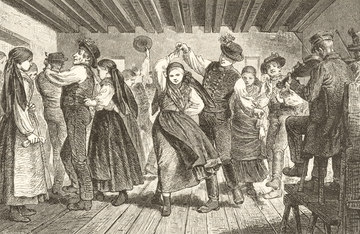The German-speakers were the Habsburg Monarchy’s largest ethnic group. In addition they were the only group with a presence in all the lands of Austria-Hungary – though to varying extents.
It was most especially in the Alpine and Danube provinces and parts of the Bohemian lands that German-Austrians made up the vast majority of the population. In addition the eastern parts of Austria-Hungary contained German-speaking enclaves of varying sizes.
The Germans were numerically the largest language group by far. In the 1910 census of the Habsburg Monarchy 12.6 million people were registered as German-speakers, making 23.9 per cent of the whole population of Austria-Hungary. The proportion was higher in the Austrian half of the Monarchy (‘Cisleithania’), where they made up a third of the population, while the figure for the Hungarian half of the Monarchy (‘Transleithania’) was only a little more than 10 per cent.
The centre of gravity of the German-speaking population lay in the Danube and Alpine provinces, where some of the crown lands were in fact almost entirely German-speaking, most notably the provinces of Salzburg, Vorarlberg, and Upper and Lower Austria – though in the last case an exception has to be made for Vienna (part of Lower Austria until 1922), which as the capital was a magnetically attractive destination for migrants from all parts of the Monarchy.
Furthermore, the German-speakers predominated in Styria (70.5%), Carinthia (78.6%) and Tyrol (57.3%). These regions often witnessed conflicts between the nationalities, as the Germans’ resolute and unyielding insistence on the primacy of German in education and administration was increasingly challenged by the respective minorities (Slovenes in Styria and Carinthia, Italians in Tyrol).
The opposite situation obtained in the Bohemian lands, where the Germans were a minority, though definitely a minority of great cultural and economic importance. In Bohemia itself, where Germans made up 36.8 per cent of the population, they were at their densest in the north and west, with the centres being Reichenberg (Czech: Liberec) and Eger (Cheb); in south Bohemia they were somewhat less strongly represented. In Moravia the Germans made up 27.6 per cent of the population. Although the highest concentrations were in the south and the north, Moravia also had a large number of German-speaking enclaves, with influential German urban elites dominating life in towns as Brünn (Czech: Brno) or Iglau (Jihlava). In Austrian Silesia, where there was no clearly dominant language group, the Germans were nevertheless the largest group with 43.9 per cent of the population, which gave them a relative majority over the Poles and the Czechs.
The Bohemian lands were the scene of serious conflicts between the Czechs and the Germans. While the most radical German nationalists aimed to remove the German areas of settlement from the historic lands of the Bohemian crown, the representatives of the Czech majority laid claim to overall hegemony and insisted on the inviolability of the crown territory in its historical form by appealing to Bohemian constitutional law.
In the other lands of Cisleithania, Germans were only present in scattered enclaves (in the Gottschee/Kočevje region of Carniola, for example), or they were there to represent the central state authorities in the bureaucracy or the army, or they formed social elites (nobility, grande bourgeoisie) that did not make up a significant proportion of the overall population.
One special case was the far-flung crown land of Bukovina, where no nationality had a dominant majority. That the German-speaking group here was relatively strong was largely due to the Jews, who made up the vast majority of the 21.2 per cent of the Bukovinian population who were German-speakers.
In the Hungarian half of the Monarchy the Germans were a minority group and were subjected to strong Magyarization just as the other non-Magyar nationalities were. The German-speakers made up 10.4 per cent of the population (in Croatia 5.1%), with the percentages tending to decline as more and more Germans transferred their loyalty to the Hungarian national cause, especially in the towns. Some of these German presences had originated in medieval colonization. This was the case in western Hungary, in Upper Hungary (now part of Slovakia and Romania) with its ‘Bergstädter’ and ‘Zipser’ Germans, and in Transylvania with the Saxons of Siebenbürgen. In addition there were areas of central and southern Hungary that had been resettled with Germans (Danube Swabians, Banat Swabians) in the eighteenth century after being devastated by the long years of war against the Ottomans.
Translation: Peter John Nicholson
Rumpler, Helmut/Seger, Martin (Hrsg): Die Habsburgermonarchie 1848–1918, Band IX/2: Soziale Strukturen, Wien 2010
Sutter, Berthold: Die Deutschen, in: Wandruszka, Adam/Urbanitsch, Peter (Hrsg.): Die Habsburgermonarchie 1848–1918, Band III: Die Völker des Reiches, Wien 1980, Teilband 1, 154–339
Urbanitsch, Peter: Die Deutschen in Österreich, Statistisch-deskriptiver Überblick, in: Wandruszka, Adam/Urbanitsch, Peter (Hrsg.): Die Habsburgermonarchie 1848–1918, Band III: Die Völker des Reiches, Wien 1980, Teilband 1, 33–153
-
Chapters
- The German-Austrians in the Habsburg Monarchy
- German Austrians or Austrian Germans?
- Holding the Monarchy together: The German-Austrians as the guarantors of Habsburg statehood
- In search of the Fatherland: The genesis of the German nation
- To join or not to join? Austria and the process of German unification
- Fear of losing hegemony: The German-Austrians in the Austrian multi-national state
- The radical German nationalists and their attitude to the Habsburg Monarchy
- The concept of ‘German Central Europe’




